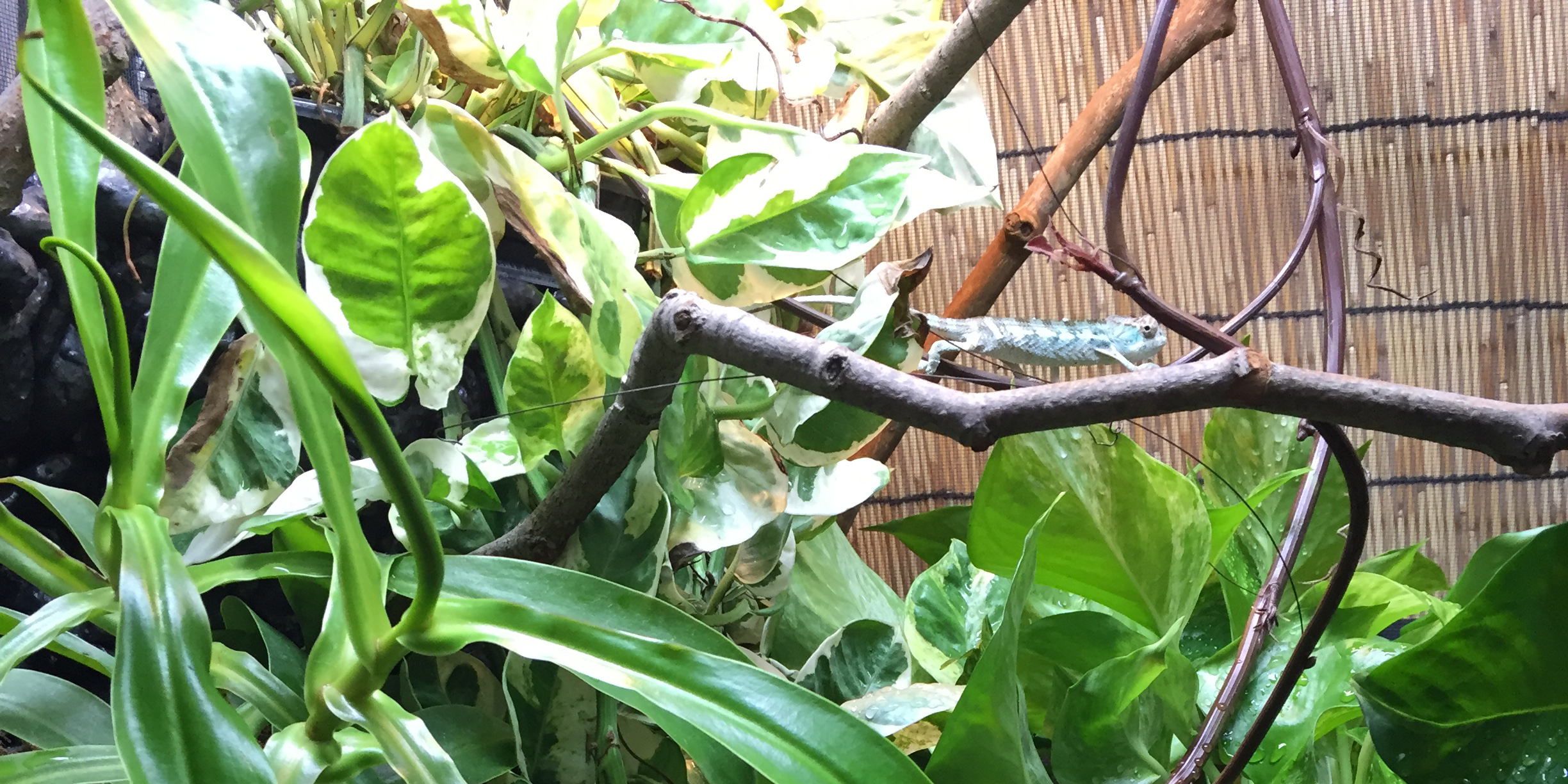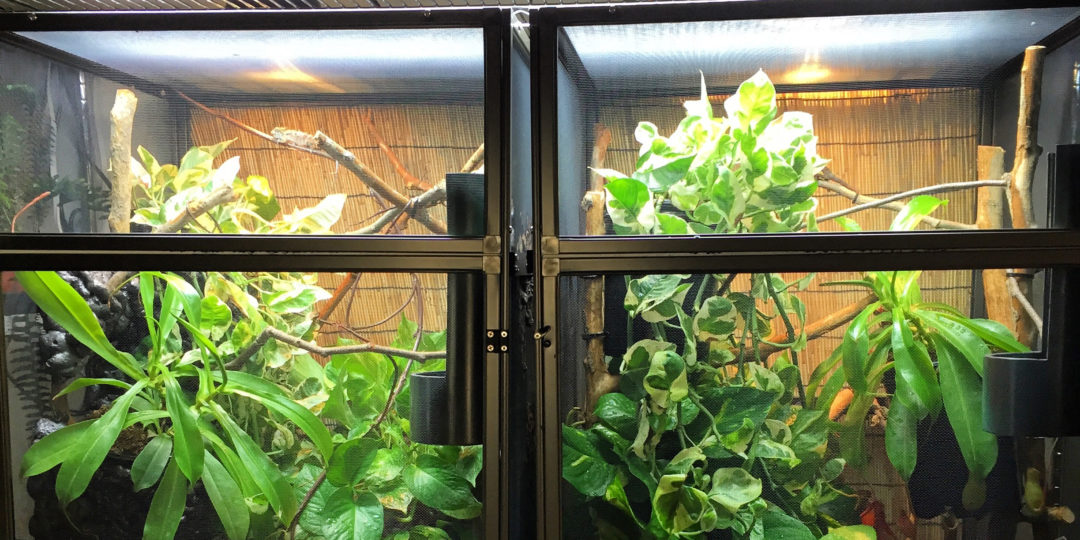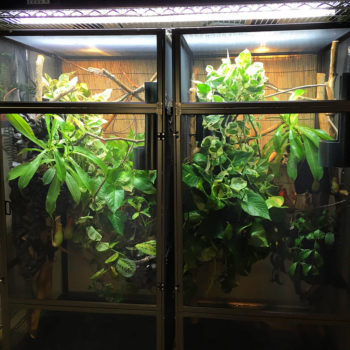Course: Setting Up a Chameleon Cage
In this course we explain the theory behind your chameleon cage set-up. When completed you should be able to identify what is an appropriate captive chameleon environment. This course is presented in four sections
- Chameleon Cage Build Theory: You are given a base of knowledge as to what is necessary for proper chameleon husbandry. I will go over what a chameleon does during the day and what it needs to be happy. I will then go over the natural environmental conditions the chameleon developed to thrive within and how we will successfully recreate those conditions in a cage.
- Setting Up The Chameleon Environment: Here I get my hands dirty (literally) and describe how to set up a cage interior so a chameleon will call it home. I review the equipment, placement, and timing I use to create a chameleon environment that makes them comfortable and nourished.
- Cage Build Guides: In this section I will guide you through setting up a complete system using the principles given in this course. Here is your step-by-step recipe!
If you are pressed for time, jump to section three and just follow the instructions to a complete and effective chameleon set-up! (You can come back and read the rest with your chameleon hanging out in his bushes.)
Section 1: Chameleon Cage Build Theory

One of the most important things we can do as chameleon keepers is ensure that our chameleons are given a suitable home. Often, chameleons are given a bad rap for being fragile. But, in the right environment, chameleons are actually incredibly hardy creatures! The cage we make for our chameleon will be its home for the rest of its life; a good cage will ensure that life is a long and healthy one. This course is designed to give you the information you will need to build the best home possible for your miniature tree dragon. Specifically, we will be going over how to use the Forest Edge 5+5 method to bring all the benefits of the forest edge into the 2’x2’x4’ cage in your living room.
In biology, the word “edge” is used to describe the space where two different habitats meet, like when the trees stop and the meadow begins. It is this area at the edge of the trees that chameleons spend most of their lives. They sleep in a protected area. When morning comes, they drink dew off the leaves and head out to warm up in the rising sun. As the day heats up, they retreat back into the shade of the leaves. They come back out in the evening, after it’s cooler, and hunt. They return to a protected area to sleep before nightfall, and the cycle repeats the next day.
It is our job, as chameleon keepers, to replicate this forest edge in our cage, ensuring that our pets have places to sleep, to hunt, to drink, and to sun themselves as they please.
Module 1
Creating A Home For Your Chameleon
A Home Made For Your Chameleon
I present what a chameleon’s home should look like to best provide for chameleon needs.
Module 2
Environmental Conditions for Chameleons
Environmental Conditions
In this module I review sun, rain, fog, and the weather conditions we want to provide.
Module 3
Plants For Your Chameleon Cage
Module 4
Assembling Your Chameleon Cage
Assembling Your Chameleon Cage
We take that box full of panels and screws and create a chameleon cage!
Module 5
Branching, Planting, And Pulling It All Together!
Branch Selection and Arrangement
Learn what makes a good chameleon branch and how to use them!
Module 6
The Sun: Setting Up Lighting, UVB, and Heat
Module 7
Setting Up a Chameleon Hydration Strategy
Naturalistic Hydration Strategy
Learn how to create a naturalistic hydration strategy.
Module 8
Setting Up Hydration Equipment
Module 9
Placing Your Chameleon Cage in Your Home
Placing the Chameleon Cage
Finally, we place our finished cage strategically in the house.
Section 3: Chameleon Cage Case Study
In the below case study I take a common cage and build it out as a demonstration of all the principles we have discussed.
Note: As an Amazon Associate I earn from qualifying purchases.
2' x 2' x 4' Screen Cage Case Study
2' x 2' x 4' Cage Build
We will apply the Forest Edge 4+4 method to a 2′ x 2′ x 4′ Screen Cage.
3' x 18" x 3' Screen Cage Case Study
3' x 18" x 3' Cage Build
We will apply the Forest Edge 4+4 method to 3′ x 18″ x 3′ Screen Cage.
Navigation
Setting Up Your Chameleon Cage is a class that is part of the Term 1: Getting Started With Chameleons coursework which gives you a basic exposure to the important issues in chameleon husbandry. Once you have the cage set up you the get into maintenance mode where you are now looking for behavior cues from your chameleon to personalize their cage experience to their particular liking. This is where it gets personal and you get to start learning about what makes your chameleon an individual! Check it out in the next course, Maintaining Your Chameleon Cage!





